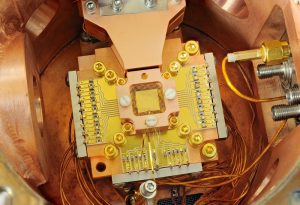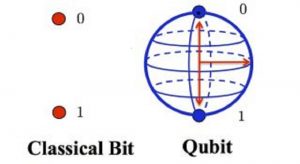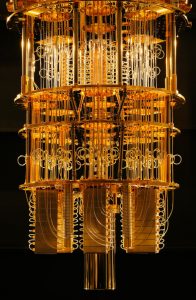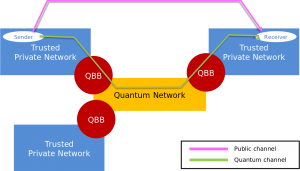You’ve probably seen the words “quantum computing” floating around the internet over the past couple of years. In fact, you might have even heard that it’s the thing that will revolutionize society as we know it today or is a purely theoretical piece of vaporware that promises a lot but will deliver zilch.
Is it either of these things? Well, much like particles in quantum physics, it’s a yes and no.
Quantum computing is a new type of computing architecture that relies on the behavior of particles in the subatomic level to store information securely and to transmit that data across great distances faster than the speed of light.
If you’re having a hard time wrapping your head around that, you’re not alone.
What is Quantum Computing?
 At its most basic, quantum computing is the use of quantum mechanics to perform complex computations. Quantum computing relies on cornerstone ideas in quantum physics, one of them being entanglement. Entanglement is a concept wherein two particles that have previously interacted will mirror the state of the other particle, no matter how far they are from each other.
At its most basic, quantum computing is the use of quantum mechanics to perform complex computations. Quantum computing relies on cornerstone ideas in quantum physics, one of them being entanglement. Entanglement is a concept wherein two particles that have previously interacted will mirror the state of the other particle, no matter how far they are from each other.
This mysterious connection was once rejected by Einstein in the 30’s, calling it a “spooky action” that was unexplainable. Although today we have abundant proof of entanglement’s existence, the force or energy behind the connection of two entangled particles remains unclear. What is clear, however, is that information from one particle is transmitted almost instantaneously to the other particle.
Think of it this way: imagine 2 subatomic particles being born out of the same atom, with particle A spinning in one direction, and particle B spinning in the opposite direction. Assuming that they’ve been entangled, separate the particles by placing one particle at one end of the universe and its partner on the exact opposite side. If particle A’s spin changes, so will particle B’s, and this change will happen instantaneously. This immediate transmission of information is crucial in quantum computation, as the use of entangled particles means that a quantum computer can make extremely complex calculations instantaneously.
Quantum computing also takes advantage of a concept called “quantum superposition”. Quantum superposition is the process of subatomic particles being in two states at the same time. This is important because it means that a subatomic particle contains vastly more information than a regular particle.
 In classic computing, information is stored in binary digits, or “bits”, that are in one of two states: 1 or 0. In quantum computing, information is stored in quantum bits, or “qubits”, that are in both states of 1 and 0, thanks to quantum superposition. Think of it this way: imagine that a unit of information looked like a sphere. A classic bit could be found as either a 1 in the north pole of the sphere, or a 0 in the southern pole. In quantum computing, a qubit can be found on any point of the sphere. This means that a qubit can store and process information more efficiently and in larger quantities.
In classic computing, information is stored in binary digits, or “bits”, that are in one of two states: 1 or 0. In quantum computing, information is stored in quantum bits, or “qubits”, that are in both states of 1 and 0, thanks to quantum superposition. Think of it this way: imagine that a unit of information looked like a sphere. A classic bit could be found as either a 1 in the north pole of the sphere, or a 0 in the southern pole. In quantum computing, a qubit can be found on any point of the sphere. This means that a qubit can store and process information more efficiently and in larger quantities.
Putting those two concepts together, quantum computers can solve extremely complex equations and calculations instantaneously while simultaneously requiring less energy and, theoretically, smaller physical structures to house them.
How Do They Make It Work?
 While it all sounds great in theory, actually building a quantum computer poses unique challenges, some of which involve solving some of quantum physics’ unanswered problems.
While it all sounds great in theory, actually building a quantum computer poses unique challenges, some of which involve solving some of quantum physics’ unanswered problems.
In classic computing, adding bits requires installing microscopic circuitry into a chip, which is difficult as is. In quantum computing, adding qubits requires creating a subatomic particle with the same entanglement as existing qubits, which is even more difficult than adding microscopic circuitry. Adding new qubits or too much interference from the outside world also runs the risk of destroying the existing entanglement of the other qubits. This makes scaling up quantum computers extremely difficult.
To build the physical structures of a quantum computer, scientists attempted using superconducting materials, trapping ions or individual neutral atoms in an ion trap, or molecules of different structures. However, they have yet to make a structure that lets the qubits retain information for long periods of time. Other scientists attempted using ultracold molecules, a cluster of two atoms to act as qubits and kept in freezing conditions for better control, with limited results.
The latter method, however, produced a qubit that was able to hold on to information for longer than a second. This might not seem much but considering that previous attempts yielded qubits that only held on to information for milliseconds at a time, this was a huge improvement.
Recently, however, researchers from the University of New South Wales claimed to have had a significant breakthrough: a new type of qubit called a “flip flop qubit”. A flip flop qubit uses the electron and the nucleus of a phosphorus atom, with researchers using an electric signal rather than magnetic ones to manipulate them. This has allowed for easier distribution of the qubits, which in turn allow for better information retention.
At the moment, quantum computers are bulky, modular machines that can only work in specialized conditions, echoing its ancient ancestor, the ENIAC. Scalable models might seem far away, with some researchers predicting commercial models being available by the year 2050, but continuous research in quantum physics, engineering, and mathematics are all helping to lessen that time.
What Does it Mean for Us?
Quantum computing can analyze and organize billions of data sets in an instant, and this would be helpful not just in physics, but in everyday life. When perfected, quantum computing promises to solve some of the most complex computations possible, from mapping out protein folds and predicting complicated chemical reactions to solving city congestion and creating models for optimized sports systems.
Cryptography would also undergo a revolution should quantum computing become available. Regular encryption requires protecting information beneath layers upon layers of extremely complex mathematical equations. With quantum computing, however, this becomes obsolete, as all those equations can be solved instantaneously.
On the flipside, quantum computation could also bolster cryptography. A new type of cryptography based on quantum mechanics is being developed by researchers called Quantum Key Distribution, QKD. QKD relies on the ever-changing nature of particles to protect information. A QKD system would use a quantum key to encrypt information needed to decode a message by sending it as particles, usually photons. If hackers try to view this key, the simple act of observing the particle changes its behavior, thus making the key unusable.

Using a variation of quantum cryptography, researchers in China have started building a new kind of internet that’s called quantum networks. These quantum networks would be an extremely secure and extremely fast version of the internet we all know and love now, with information being almost un-hackable.
The future of quantum computing, while promising, is as vague as the principles it relies on. Indeed, much like subatomic particles, if one observes quantum computing for too long, it might just change the outcome entirely.